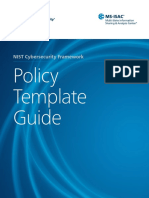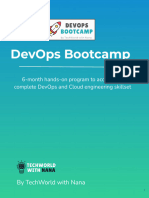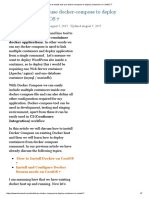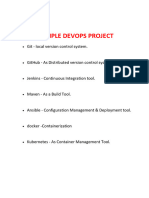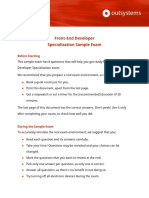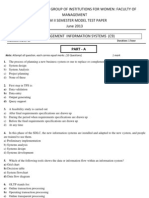Kubernetes Hardening Security
Kubernetes Hardening Security
Uploaded by
Vasile Irimia0 ratings0% found this document useful (0 votes)
109 views12 pagesThis document outlines 11 ways to improve Kubernetes security, including enabling TLS everywhere, using role-based access control with least privilege, separating and firewalling the etcd cluster, regularly rotating encryption keys, using Linux security features like capabilities and SELinux, running containers as non-root users, implementing network policies, scanning container images for vulnerabilities, and running an intrusion detection system.
Original Description:
Original Title
kubernetes-hardening-security
Copyright
© © All Rights Reserved
Available Formats
PDF, TXT or read online from Scribd
Share this document
Did you find this document useful?
Is this content inappropriate?
Report this DocumentThis document outlines 11 ways to improve Kubernetes security, including enabling TLS everywhere, using role-based access control with least privilege, separating and firewalling the etcd cluster, regularly rotating encryption keys, using Linux security features like capabilities and SELinux, running containers as non-root users, implementing network policies, scanning container images for vulnerabilities, and running an intrusion detection system.
Copyright:
© All Rights Reserved
Available Formats
Download as PDF, TXT or read online from Scribd
Download as pdf or txt
0 ratings0% found this document useful (0 votes)
109 views12 pagesKubernetes Hardening Security
Kubernetes Hardening Security
Uploaded by
Vasile IrimiaThis document outlines 11 ways to improve Kubernetes security, including enabling TLS everywhere, using role-based access control with least privilege, separating and firewalling the etcd cluster, regularly rotating encryption keys, using Linux security features like capabilities and SELinux, running containers as non-root users, implementing network policies, scanning container images for vulnerabilities, and running an intrusion detection system.
Copyright:
© All Rights Reserved
Available Formats
Download as PDF, TXT or read online from Scribd
Download as pdf or txt
You are on page 1of 12
11 Ways (Not) To Get Hacked
1. TLS Everywhere
TLS should be enabled for every component that supports it
to prevent traffic sniffing, verify the identity of the server, and
(for mutual TLS) verify the identity of the client.
Autoscaling Kubernetes nodes was historically difficult, as
each node requires a TLS key to connect to the master, and
baking secrets into base images is not good practice.
Kubelet TLS bootstrapping provides the ability for a new
kubelet to create a certificate signing request so that
certificates are generated at boot time.
2. Enable RBAC with Least Privilege, Disable ABAC, and
Monitor Logs
Role-based access control provides fine-grained policy
management for user access to resources, such as access
to namespaces.
3. Use Third Party Auth for API Server
Centralising authentication and authorisation across an
organisation (aka Single Sign On) helps onboarding,
offboarding, and consistent permissions for users.
Integrating Kubernetes with third party auth providers uses
the remote platform's identity guarantees and prevents
administrators having to reconfigure the Kubernetes API
server to add or remove users.
4. Separate and Firewall your etcd Cluster
etcd stores information on state and secrets, and is a critical
Kubernetes component - it should be protected differently
from the rest of your cluster.
etcd should be configured with peer and client TLS
certificates, and deployed on dedicated nodes.
5. Rotate Encryption Keys
A security best practice is to regularly rotate encryption keys
and certificates, in order to limit the "blast radius" of a key
compromise.
Kubernetes will rotate some certificates automatically
(notably, the kubelet client and server certs) by creating
new CSRs as its existing credentials expire.
6. Use Linux Security Features and PodSecurityPolicies
The Linux kernel has a number of overlapping security
extensions (capabilities, SELinux, AppArmor, seccomp-bpf)
that can be configured to provide least privilege to
applications.
7. Statically Analyse YAML
Where PodSecurityPolicies deny access to the API server,
static analysis can also be used in the development
workflow to model an organisation's compliance
requirements or risk appetite.
8. Run Containers as a Non-Root User
Containers that run as root frequently have far more
permissions than their workload requires which, in case of
compromise, could help an attacker further their attack.
9. Use Network Policies
By default, Kubernetes networking allows all pod to pod
traffic; this can be restricted using a Network Policy.
10. Scan Images and Run IDS
Web servers present an attack surface to the network they're
attached to: scanning an image's installed files ensures the
absence of known vulnerabilities that an attacker could
exploit to gain remote access to the container. An IDS
(Intrusion Detection System) detects them if they do.
11. Run a Service Mesh
A service mesh is a web of encrypted persistent connections,
made between high performance "sidecar" proxy servers like
Envoy and Linkerd. It adds traffic management, monitoring,
and policy - all without microservice changes.
You might also like
- Kubernetes For Teenagers (English)Document26 pagesKubernetes For Teenagers (English)Francisco Leon GutierrezNo ratings yet
- Artifactory With Amazon Ecs On The Aws Cloud PDFDocument37 pagesArtifactory With Amazon Ecs On The Aws Cloud PDFKevin MadhuNo ratings yet
- Udemy Docker Advanced PDFDocument71 pagesUdemy Docker Advanced PDFmf0% (1)
- Preliminary: Engine and Control SystemsDocument24 pagesPreliminary: Engine and Control SystemsAnderson VulczakNo ratings yet
- Policy Template Guide: NIST Cybersecurity FrameworkDocument17 pagesPolicy Template Guide: NIST Cybersecurity FrameworkHesham Elsayed100% (1)
- The Gorilla Guide To Kubernetes in The Enterprise PDFDocument62 pagesThe Gorilla Guide To Kubernetes in The Enterprise PDFSam CharringtonNo ratings yet
- Jenkins User HandbookDocument204 pagesJenkins User HandbookEduardo GabrielNo ratings yet
- Kubernetes Security - Michael Hausenblas, Liz Rice PDFDocument85 pagesKubernetes Security - Michael Hausenblas, Liz Rice PDFforum4user100% (2)
- Service Manual Diesel Engine DB33ADocument78 pagesService Manual Diesel Engine DB33ADVHHTC100% (4)
- Reed, Mark - Kubernetes - The Ultimate Beginners Guide To Effectively Learn Kubernetes Step-by-Step-Publishing Factory (2020)Document88 pagesReed, Mark - Kubernetes - The Ultimate Beginners Guide To Effectively Learn Kubernetes Step-by-Step-Publishing Factory (2020)lodhe2No ratings yet
- Kubernetes III Deep DiveDocument51 pagesKubernetes III Deep DiveSai KumarNo ratings yet
- DevOps Bootcamp Full CurriculumDocument33 pagesDevOps Bootcamp Full CurriculumPhani GadivemulaNo ratings yet
- 8.terraform ModulesDocument147 pages8.terraform Modulessridr8No ratings yet
- Using Docker To Build and Test in Laptop and Jenkins: Micael GallegoDocument109 pagesUsing Docker To Build and Test in Laptop and Jenkins: Micael GallegoDodo winy100% (1)
- GCP PdevopsDocument95 pagesGCP PdevopsNishanta BanikNo ratings yet
- DevOps - para Practicar DocumentacionDocument157 pagesDevOps - para Practicar DocumentacionCesar Andy Cardenas LinoNo ratings yet
- Containerisation WithDocument74 pagesContainerisation WithviswatejaNo ratings yet
- The Docker Book - The Docker Book - James Turnbull - V17.03.0Document400 pagesThe Docker Book - The Docker Book - James Turnbull - V17.03.0Marcelo LimaNo ratings yet
- THE Definitive Cheat Sheet: KubectlDocument23 pagesTHE Definitive Cheat Sheet: KubectlkingnachiNo ratings yet
- Docker Cheat SheetDocument20 pagesDocker Cheat SheetDaniel Nuñez100% (1)
- TheNewStack Book2 KubernetesDeploymentAndSecurityPatternsDocument93 pagesTheNewStack Book2 KubernetesDeploymentAndSecurityPatternsPietro OliverNo ratings yet
- Five Principles Deploying Linux CloudDocument92 pagesFive Principles Deploying Linux CloudKevinWoodNo ratings yet
- Kubernetes SecurityDocument156 pagesKubernetes Securitysalinob813No ratings yet
- DoDEnterpriseDevSecOps SourceDiagramsDocument49 pagesDoDEnterpriseDevSecOps SourceDiagramsJhonatan RiosNo ratings yet
- Native Docker Clustering SwarmDocument269 pagesNative Docker Clustering SwarmjuanNo ratings yet
- Container Security Going Beyond Image ScanningDocument18 pagesContainer Security Going Beyond Image ScanningnicolepetrescuNo ratings yet
- Kubectl Cheat SheetDocument14 pagesKubectl Cheat SheetridteamNo ratings yet
- How To Install and Use Docker-Compose To Deploy Containers in CentOS 7 PDFDocument7 pagesHow To Install and Use Docker-Compose To Deploy Containers in CentOS 7 PDFadm84No ratings yet
- Kubernetes: A Comprehensive OverviewDocument67 pagesKubernetes: A Comprehensive Overviewabhi_j100% (1)
- Terraform+Notes+PPT+ +KPLABSDocument410 pagesTerraform+Notes+PPT+ +KPLABSjexijol603No ratings yet
- TheNewStack Book3 CICDwithKubernetes PDFDocument119 pagesTheNewStack Book3 CICDwithKubernetes PDFSteveNo ratings yet
- CI - CD ProjectDocument123 pagesCI - CD Projectrokr58100% (2)
- Ansible For TeenagersDocument23 pagesAnsible For TeenagersJignesh NakhvaNo ratings yet
- Systemdesign SampleDocument109 pagesSystemdesign Sampleraghu veerNo ratings yet
- Red Hat Service Mesh Deep DiveDocument120 pagesRed Hat Service Mesh Deep DiveFarooqNo ratings yet
- YAML-its Usage in KubernetesDocument46 pagesYAML-its Usage in Kubernetessksundar.net396100% (1)
- DevOps TutorialDocument302 pagesDevOps Tutorialgopichandedara63023100% (1)
- Terraform For TeenagersDocument27 pagesTerraform For TeenagersAntony Kervazo-CanutNo ratings yet
- Kubernetes TutorialsDocument161 pagesKubernetes Tutorialsjustin jazz100% (1)
- AWS EKS KubernetesDocument193 pagesAWS EKS Kubernetesnaik8msNo ratings yet
- A Curated List of Awesome Kubernetes Tools and ResourcesDocument16 pagesA Curated List of Awesome Kubernetes Tools and Resourcesdeniz bayraktar100% (2)
- OpenShift Container Platform 3.5 Developer Guide en USDocument293 pagesOpenShift Container Platform 3.5 Developer Guide en USSandesh AhirNo ratings yet
- Google Container Engine Interview Questions and AnswersDocument7 pagesGoogle Container Engine Interview Questions and AnswersSanjay GuptaNo ratings yet
- CKAD Study GuideDocument39 pagesCKAD Study GuideokNo ratings yet
- DevSecOps in KubernetesDocument77 pagesDevSecOps in Kubernetesmarc MacaaroNo ratings yet
- ArgoCD For TeenagersDocument24 pagesArgoCD For TeenagersAntony Kervazo-CanutNo ratings yet
- Fast Lane - RH-DO180Document3 pagesFast Lane - RH-DO180Charles WeiNo ratings yet
- Azure Kubernetes Service - Solution Booklet - DigitalDocument70 pagesAzure Kubernetes Service - Solution Booklet - DigitalwwongvgNo ratings yet
- Kubernetes Workshop ContainerdaysDocument80 pagesKubernetes Workshop ContainerdaysPublicNo ratings yet
- Lab 2 - DockerDocument61 pagesLab 2 - DockerVidhi jainNo ratings yet
- Kubernetes CKAD Hands-On Challenge #11 Security ContextsDocument11 pagesKubernetes CKAD Hands-On Challenge #11 Security ContextsRpl MarseilleNo ratings yet
- Beginning Ansible Concepts and Application Provisioning, Configuring, and Managing Servers, Applications, and Their... (Shaun Smith, Peter Membrey)Document296 pagesBeginning Ansible Concepts and Application Provisioning, Configuring, and Managing Servers, Applications, and Their... (Shaun Smith, Peter Membrey)dchoqueNo ratings yet
- Notes TerraformDocument138 pagesNotes TerraformJuan PintoNo ratings yet
- DevOps Master Program PDFDocument5 pagesDevOps Master Program PDFkabir aneja0% (1)
- Five Strategies To Accelerate Kubernetes Deployment in The EnterpriseDocument15 pagesFive Strategies To Accelerate Kubernetes Deployment in The Enterpriseibrahim esawyNo ratings yet
- Ansile Office DocumentDocument8 pagesAnsile Office Documentshrinath bhatNo ratings yet
- Openshift PresentationDocument27 pagesOpenshift PresentationRodrigo CamposNo ratings yet
- DevOps ProjectDocument160 pagesDevOps ProjectAkhmad FarhanNo ratings yet
- Container DevopsDocument29 pagesContainer Devopsmasoboy2000No ratings yet
- Docker Inc Docker Fundamentals Course PDFDocument193 pagesDocker Inc Docker Fundamentals Course PDFJavier Morales0% (1)
- Introduction To Kubernetes and Containers - The Kubernetes WorkshopDocument77 pagesIntroduction To Kubernetes and Containers - The Kubernetes WorkshopOLALEKAN ALEDARENo ratings yet
- Case Study In OOAD and UML: Case Studies in Software Architecture & Design, #1From EverandCase Study In OOAD and UML: Case Studies in Software Architecture & Design, #1No ratings yet
- Java (Programming Language)Document21 pagesJava (Programming Language)lanaNo ratings yet
- STLCDocument6 pagesSTLCAgung WibawaNo ratings yet
- Front-End Specialization Sample Exam - enDocument11 pagesFront-End Specialization Sample Exam - enmahesh manchalaNo ratings yet
- Object Oriented Programming: Mohib Ullah Khan Lecturer NFC-IET MultanDocument24 pagesObject Oriented Programming: Mohib Ullah Khan Lecturer NFC-IET MultanRai Hassan MughisNo ratings yet
- DevOps Enablement TeamsDocument22 pagesDevOps Enablement TeamsArjun MajumdarNo ratings yet
- Proactive Maintenance ME514 ME514: Flow of PresentationDocument5 pagesProactive Maintenance ME514 ME514: Flow of PresentationAstill ArhamsvinNo ratings yet
- 07 - Timing Chain - RemovalDocument4 pages07 - Timing Chain - Removal08088338No ratings yet
- 15IS72 CASE STUDY Electricity Bill Using Factory MethodDocument4 pages15IS72 CASE STUDY Electricity Bill Using Factory Methodmark21No ratings yet
- DSS vs. MIS by AbhiruchiDocument61 pagesDSS vs. MIS by AbhiruchiADMISNo ratings yet
- CPS20 Uebersicht EDocument1 pageCPS20 Uebersicht EMehmed MuslijaNo ratings yet
- Test Bank For Guide To Firewalls and Vpns 3rd EditionDocument6 pagesTest Bank For Guide To Firewalls and Vpns 3rd EditionErik Vanlandingham100% (44)
- Ratu Fianita Priningrum - ABAP - Summarry WeeklyDocument20 pagesRatu Fianita Priningrum - ABAP - Summarry WeeklyraraNo ratings yet
- CS 2305 - Programming ParadigmsDocument2 pagesCS 2305 - Programming ParadigmsAnitha JSNo ratings yet
- Unit Test Plan - Template: Document Change HistoryDocument2 pagesUnit Test Plan - Template: Document Change HistoryPrince PrasannaNo ratings yet
- PC Worx Function Blocks v87Document82 pagesPC Worx Function Blocks v87DERRIC JOSEPHNo ratings yet
- 8110.49 CHG 1Document108 pages8110.49 CHG 1damosleyNo ratings yet
- Baja Saeindia Dfmea TemplateDocument1 pageBaja Saeindia Dfmea TemplatepreetNo ratings yet
- CP 5Document26 pagesCP 5Abhijit BhongNo ratings yet
- MISDocument3 pagesMISCharu ModiNo ratings yet
- ABB Schalt-Und SteuerungstechnikDocument18 pagesABB Schalt-Und Steuerungstechnikimagex5No ratings yet
- ADVANCED Ic Engine VtuDocument2 pagesADVANCED Ic Engine VtuNitish DesaiNo ratings yet
- Robot For M2M User GuideDocument16 pagesRobot For M2M User GuideGurudeep BNNo ratings yet
- TrimLite™ UT20706 HomeliteDocument7 pagesTrimLite™ UT20706 HomeliteBKVNo ratings yet
- Quality 101Document98 pagesQuality 101Fadille NabbouhNo ratings yet
- Testing-PPT-2-Testing-Throughout-SDLC - Part-1Document8 pagesTesting-PPT-2-Testing-Throughout-SDLC - Part-1NagfaceNo ratings yet
- Exploit Analysis: Problem Statement: For This Project, You Will Choose An Exploit From The Open-Source MetasploitDocument1 pageExploit Analysis: Problem Statement: For This Project, You Will Choose An Exploit From The Open-Source MetasploitYounes Et TalbyNo ratings yet
- How To Configure CM Services in SAP Netweaver 7.3Document100 pagesHow To Configure CM Services in SAP Netweaver 7.3Yuri SerpaNo ratings yet




